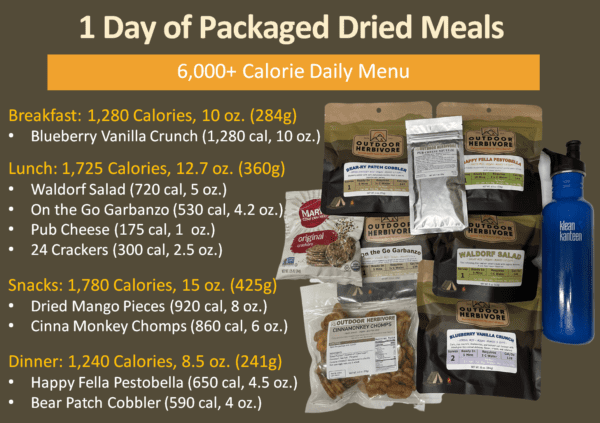
Wildland firefighting, a role that demands immense physical and mental strength, requires careful meal planning. To sustain this work output and maintain a healthy immune system, fireline firefighters will typically need to consume 6,000 calories daily. Getting proper nutrition from ultra-processed Meals Ready to Eat (MREs), packaged snacks and backpacking meals can be challenging. That’s why we recommend a less processed, plant-based diet made from freeze-dried food, which provides the most antioxidants, vitamins, and minerals to fuel the body. These are the key components we recommend for making up a wildland firefighter’s diet while in the field:
Carbs
Carbohydrates are essential for producing glucose in the blood, which fuels the muscles and brain. In the field, it’s crucial to have carbohydrate-rich foods on hand. While working, firefighters should aim to eat carbohydrates every hour between meals. Energy bars used by endurance athletes or backpackers are an excellent way to supplement the high-carb demands between meals. For example, one Greenbelly hiking meal bar contains 330-350 calories or about 650-700 calories per pouch. Another option is the Promeal bar, which has about 400 calories. Meal bars are an easy way to meet daily energy demands. We don’t recommend bars containing chocolate as they are prone to melting in heat. Keep in mind that snacks with added sugar can cause sugar spikes. Sources of healthy, carbohydrate-rich foods include whole-grain pasta/couscous, beans, corn, quinoa, rice, potatoes, and dried fruits.
Fats
Fats provide a significant amount of energy in a small package. However, it’s important to remember that fats should not make up more than 30 percent of your daily calorie intake, and plant-based unsaturated fats such as olive oil are better than saturated fat and hydrogenated fat. Healthy sources of fats include almonds, avocados, cashews, chia seeds, macadamia nuts, peanuts (peanut butter), walnuts, sesame seeds (hummus), sunflower seeds, and olive oil.
Protein
Protein is necessary for maintaining muscle mass, and firefighters should eat at least .5 grams of protein per pound of body weight daily. Vegetarian protein sources include beans, brown rice, lentils, peas, nuts, seeds, soy/tofu, wild rice, hummus (bean spreads), oats, quinoa, nutritional yeast, wheat, eggs, and cheese.
Fluids
Hydration is crucial for wildland firefighters due to rapid fluid loss from constant sweating and reliance on dried snacks. Staying hydrated is not just about quenching thirst, it’s about maintaining the body’s functions, including digestion, circulation, and temperature regulation. Dehydration can lead to fatigue, dizziness, and decreased cognitive function, all of which can impair performance on the fireline. Electrolyte/smoothie mixes will supplement daily calorie demands while aiding in hydration. For optimal nutrition, look for powdered sports drinks and instant smoothie mixes made from powdered freeze-dried fruits/vegetables.
Daily Energy Sources (approximate kilocalories)
The National Technology and Development Program (NTDP) suggests consuming 150 to 200 kcals every two hours during the work shift to maintain blood glucose and stabilize energy levels.[1] Considering an eight-hour day, that means consuming 6,000 calories. Getting enough calories will require eating three meals and supplementing with ready-to-eat snacks and liquid carbohydrates.
Meals: 4,000
Snacks: 1,000
Beverage Mixes: 1,000
Total energy = 6,000
Here’s a sample meal plan to help you visualize how to meet these energy requirements using freeze-dried meals and snacks:

Nutritional Recommendations for Firefighters
- Consume meals featuring complex carbohydrates (potatoes, corn, rice, beans, whole-grained bread, and pasta), moderate amounts of healthy fats, and protein.
- To supplement fat calories, add a handful of healthy fats, such as nuts or a spoonful of olive oil, to dry meals. One cup of chopped walnuts has 200 calories, and one TB of olive oil contains 100 calories.
- Consume carbohydrate calories from fluids by adding powdered sports mixes to drinking water. Liquid calories will fuel the body much quicker than solid foods.
- Consume supplemental carbohydrate energy (energy bars, trail mixes, dried fruit) between meals.
- Eat 3 cups of dried fruits and vegetables daily to maintain immune and digestive health. Freeze-dried vegetables are excellent for adding to meals to meet requirements.
- Consider no-cook, cold-rehydration meals during extreme heat and severe conditions to make eating easy and quick. Outdoor Herbivore has a wide range of no-cook meals.
Wildland firefighting is physically demanding work, and proper nutrition is essential for staying energized and focused. With the proper fuel, you can tackle the challenges of the job with confidence and resilience. A balanced diet with carbohydrates, healthy fats, protein, and fluids will help you perform at your best and stay safe. This diet, similar to what thru-hikers follow, is designed to meet the energy demands required to remain strong and healthy in your fight.
Outdoor Herbivore works with the National Forest Service to supply nutritious compact meals to wildland firefighters and rescue groups. Please contact us if you want a quote for supplying backpacking meals for your unit.
